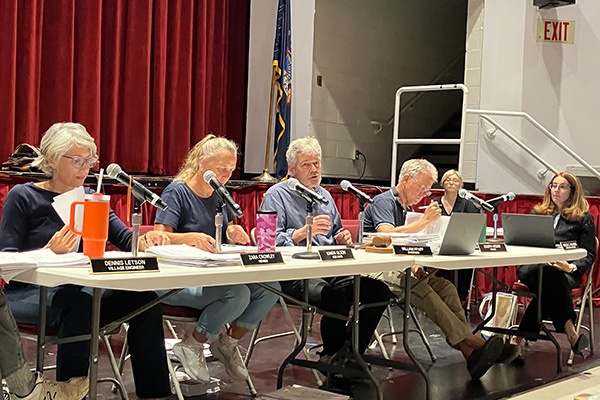|
RCBJ-Audible (Listen For Free)
|
Traffic, Safety, And Emergency Access Dominate Agenda At Public Hearing On Congregation Ramapo Cheder’s Proposed School In Upper Nyack
To secure a Special Permit to operate a Jewish Day School at the former Alliance Theology Seminary on Route 9W in Upper Nyack, Congregation Ramapo Cheder must have a second egress from the property in the event of an emergency.
Alliance Theological Seminary operated for more than 50 years without a second egress for its student body, but changes to the Village Code in 2021 imposed the additional egress requirement on day schools, as well as houses of worship, and not-for-profit community centers.
At a Planning Board meeting last week, held at the Nyack High School auditorium, nearly 300 residents turned out to listen to the presentation by Ramapo Cheder’s lawyers, engineers and traffic experts, and to pose questions and concerns about the project at 350 North Highland Avenue, and its impact on nearby properties including Nyack High School (situated north of the site) and Route 9W traffic.
Residents, in the short window allotted to public comment, about 20 minutes out of the two-hour meeting, expressed skepticism over the traffic engineer’s report, as well as concerns about a proposal to add a second egress between the existing driveway and the planned reconfiguration of the access to Nyack High School. Nyack High School Schools Superintendent Dr. Lizzette Ruiz-Giovinazzi also raised concerns.
“We are not in support of granting waivers,” she told the Planning Board.
Residents who spoke honed in on traffic concerns.
The existing ingress/egress at 350 North Highland Avenue sits about 130 yards from Nyack High School’s ingress/egress on Route 9W. The High School plans to relocate its entrance on 9W to the corner of Birchwood, which would close the gap between the school entrances and the Ramapo Cheder’s emergency entrance to 80 yards, according to Google Earth.
The proposed second egress at the Ramapo Cheder, the one required by code, would be gated, and only used in emergency situations, but the three driveways, if the plans are approved, would be close to together. Because Highland Avenue is a state road, any changes to the driveways and related curb cuts would have to be approved by the New York State Department of Transportation.
“Given this project involves young children, full compliance with safety codes has to be the baseline,” said Suzanne Dakessian. “This school would bring hundreds of students and staff on site daily, yet it lacks a code-compliant second means of egress. The Nyack Fire Department has already stated it cannot support the current plans. Life-safety standards exist for a reason.”
As part of the application for the Special Permit, the Village of Upper Nyack required the school to provide a traffic study, and to pay for the Village’s traffic engineer to review and comment on the study. Colliers Engineering’s study was submitted for review in May. Upper Nyack’s experts reviewed the study last week.
According to information provided by Colliers, the student body would require a maximum of 13 buses.
Ramapo Cheder proposed to accommodate 440 students, but would not have any dormitories or residents on the campus. The report says 44 of the 440 students would attend a Pre-K program. 70 staff members would be on the campus during the school day, which would operate six days a week, including Sundays.
The traffic study focused on existing traffic conditions and how those conditions would be impacted in the future if nothing was built, compared to how the traffic would be impacted by the proposed project. Traffic counts were taken in April, on both school days and a weekend day; only three days of traffic were counted. These counts were used to estimate future traffic in the corridor.
Colliers utilized a conservative expected annual growth rate on Route 9W of 5 percent, though Rockland County’s expected growth rate for traffic in the Route 9W corridor as established by the New York Metropolitan Transportation Council (NYMTC) is only 0.78 percent. In other words, Colliers assumed traffic would grow at about six times the rate the NYMTC expected. The report also studied a series of intersections along Route 9W from Christian Herald, Glenbrook, Nyack High School Driveway, Birchwood, and Riverton (North and South).
The study looks at the impact on the Level of Service (LOS) for signalized and unsignalized intersections, and how the added traffic affects the LOS.
A Level of Service “A” represents the best condition, and a Level of Service “F” represents the worst condition. A Level of Service “C” is generally used as a design standard while a Level of Service “D” is acceptable during peak periods. A Level of Service “E” represents an operation near capacity. In order to identify an intersection’s Level of Service, the average amount of vehicle delay is computed for each approach to the intersection as well as for the overall intersection.
According to Colliers’ engineer, the intersection at Christian Herald, the High School Driveway, Riverton (North & South) and other intersections will be no worse than they already are. The report acknowledges the Glenbrook intersection having the worst LOS, but the traffic study says that the LOS will not be any worse than it already is.
The report also anticipates that Ramapo Cheder will not have an adverse impact on the relocated Nyack High School driveway on Route 9W when it is constructed.
Traffic studies often fail to consider the broader impacts of transportation projects, such as air pollution, noise, safety, and the overall quality of life. The focus on moving cars and intersection delays can overshadow the potential negative consequences for pedestrians, cyclists, and communities. And, studies may not adequately address the needs of all users, including those with disabilities, those who rely on alternative transportation, and those special uses on particular roads like ambulances, firefighters and police who need clear access and are harmed by increased traffic counts on important thoroughfares.
The property spans 36 acres, 15 of which are located in the Town of Clarkstown. In Upper Nyack, the property straddles two zoning districts, the OB (Office/business) and the R-80 (Conservation) zones. A search of the applications make no mention of Nyack Building, LLC.
Because of the nature of the application — reuse of an existing building — there is limited environmental review available under New York’s State Environmental Review Act (SEQRA). Despite the lack of SEQRA review, the Village Planning Board is looking at many of the same impacts as part of its review of the application for a Special Permit.
Both New York State and federal law (RLUIPA) requires municipalities to be flexible in the application of their zoning code to educational and religious uses. These laws generally apply to Special Permits and variances.
Because part of the parcel sits in the Town of Clarkstown, it must also have an opportunity to review the application. And because the property borders the Village of Nyack, it will also have an opportunity to weigh-in on the impacts to Nyack.
Viznitz closed on the property in 2020. The Upper Nyack former seminary building has sat vacant since being acquired.
The Planning Board kept the public hearing open to a later date when it will accept additional public comment. The next Planning Board meeting is scheduled for July 23rd at 6:00, at Nyack High School’s auditorium.
















